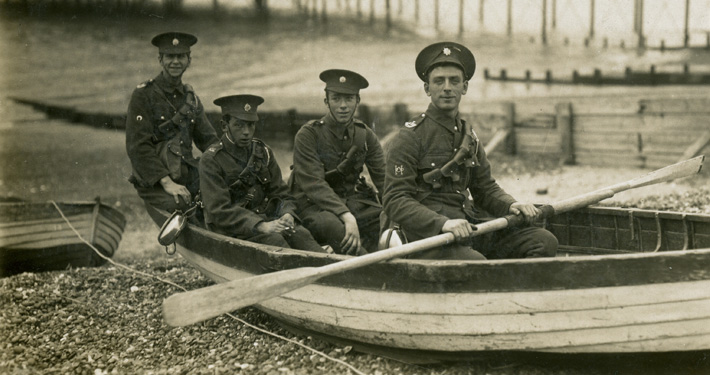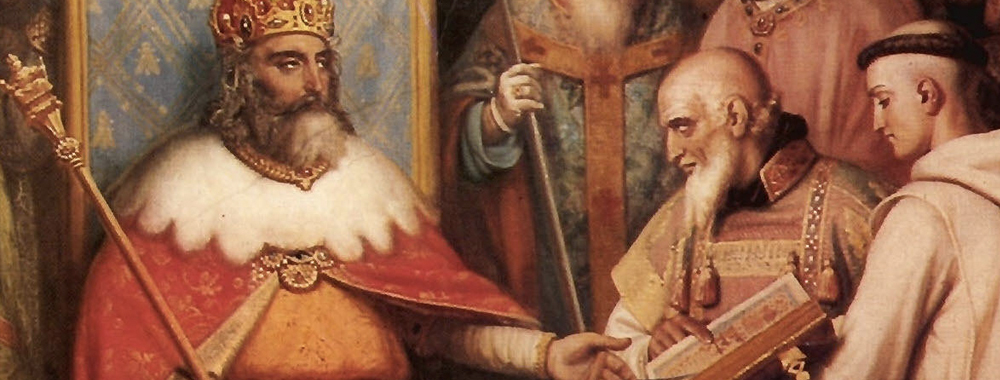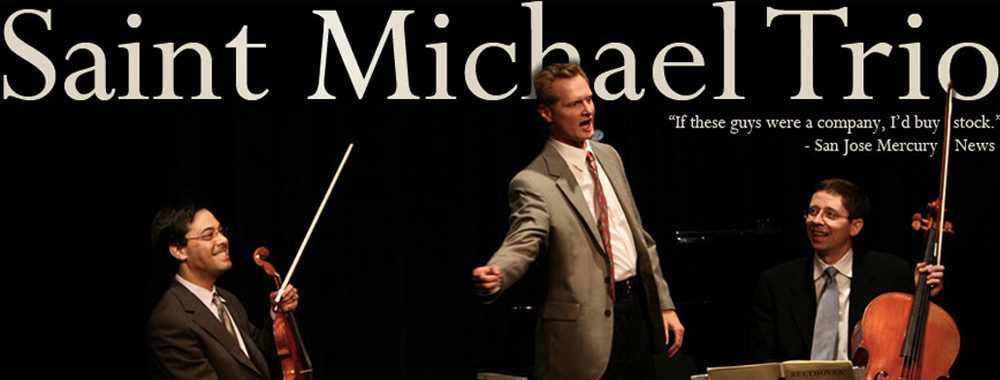Marines’ Memorial Theatre, San Francisco
The First World War collapsed empires, redrew national boundaries, caused cataclysmic change in a generation of Europeans, and revolutionized long-held worldviews all across Europe. From 1914-18, “The Great War” raged amid a vast crisis of cultural confidence. The war to end all wars was a monumental catastrophe, one of history’s major turning points. Yet among The Great War’s legacies of drastic political, social, and cultural change in Europe has been its immense artistic response in music, art, literature, and film.
“What did you do in the Great War Mr. Joyce?”
“I wrote Ulysses. What did you do?”
Friday, May 1, 2014, 7:30-9:30 pm
The Great War: Monumental Catastrophe, Cataclysmic Change / Tyler Stovall (UCSC). World War I marks the beginning of the twentieth century, and the modern age in general. It replaced the self-assured European civilization of the nineteenth century with a new era based not on peace and progress but on conflict and uncertainty. It toppled empires, replacing them with uncertain experiments in liberal democracy, socialist revolution, and fascism. Finally, as the first truly global conflict, it created the idea of a unified world that has remained with us ever since. This keynote outlines the main features of the war, both on and off the battlefield, a cataclysm that both destroyed the old world and at the same time created the new era.
Performance: Postwar Parisian Mélodies / Daniel Lockert and Eliane Lust (piano) withMolly Wilson (soprano). In 1917 Paris, Jean Cocteau, Erik Satie, Pablo Picasso, Sergei Diaghilev and Les Ballets Russes created the ballet Parade, a work of derision and a great scandal. Men were dying at the front and, in Paris, it had become the practice to mock established values. The contrast between the brutality of the modern world and the poetic universe of the ballet is a bias of lightness in the middle of The Great War. Following this, a tremendous creative output emerged, starting with the collaboration of Satie, Cocteau and a group of new musicians known as Les Six. They wanted to break with the past and with impressionism, and to create an everyday music with a style closer to that of popular Parisian night life.
Saturday, May 2, 2015, 10 am – noon and 1:30-4:00 pm
The War Within the War / Adam Hochschild (Mother Jones and UC Berkeley). The First World War was such a momentous historical turning point that we forget that, at the time, many people questioned whether it should be fought at all. In each of the major countries that took part there was tension between those who felt the war was a glorious and necessary crusade and those who felt the immense scale of killing made participating in the war an act of madness. Nowhere was the conflict more dramatic than in Britain, where more than 20,000 men of military age refused to be drafted. Many conscientious objectors also rejected alternative defense work, and some 6,000 of them went to prison under extremely harsh conditions—the largest number of people, up to that time, ever imprisoned for political reasons in a Western democracy. This moral battle over the war is one that Adam Hochschild brings alive here in a talk accompanied by photographs, film and music.
Postwar Art and Gender Dynamics / Jennifer Shaw (Sonoma State University). The First World War fundamentally changed gender dynamics in Europe. Social changes resulting from the war led to the emergence of the “modern woman” or “garçonne.”—a woman who wore trousers, cropped her hair, drove a car, and even smoked. The modern woman was, in theory, both intellectually and sexually free and uninterested in giving up her freedom to return to the hearth and home. The Modern Woman was for some a positive figure of liberation and for others a source of great worry. The War had resulted in greater casualties than had ever been known. In France, anyone who didn’t fulfill traditional gender roles and thus help to boost the population was considered a threat to the reconstruction of France. Not surprisingly, cultural anxieties resulting from the trauma of WWI were also projected onto homosexuals. In the face of these perceived threats to the social order, the reconstruction of France involved a cultural campaign to promote traditional values through art and literature. At the same time, Dadaists, Surrealists and other members of the avant-garde challenged this conservatism and the cultural values that they perceived as having led to the destructive war.
Performance. Kabarett! Join the Matlock Duo–husband and wife team Daniel Lockert and Jenny Matteucci–as they recreate music from the golden era of the Weimar Republic, the period in Germany between World War 1 and 2. This period of music was renowned for its cultural and political cabarets (or Kabaretts). It was a period of enormous artistic creativity, where classical and popular music commingled and was heavily influenced by the new phenomenon of jazz. No subject was taboo in the world of the Weimar Republic, heavily centered in Berlin. We begin with the music of Frederick Hollander (1896-1976) and Mischa Spoliansky (1898-1985), culminating in the foremost representative of the style, Kurt Weill (1900-1950), with music from his popular “Die Dreigroschenoper” (3-Penny Opera) and beautiful art songs of the period.
“That Old Lie”: Literature and Art After World War I. Bruce Avery (SFSU). In April of 1922 Konstantin Stanislavski, the co-founder of the Moscow Art Theater and the father of modern acting technique, told his friend and colleague Vladimir Nemirovich that he no longer wanted to produce Chekov’s works—the very plays that had established the MAT and Stanislavski’s own method and career. His reason? “After all we’ve been through it’s no longer possible to weep over the fact that an officer is going and leaving his lady friend behind.” What they had “been through” was World War I, and Stanislavski’s response to that war is characteristic of an entire generation of writers and artists across the western world. The problem for them was this: once they decided the old stories were no longer worth telling, what kind of stories could they tell? The answer to that question produced a revolution in art and literature across the globe, an outpouring of paintings, stories, poems, novels, and plays new in both subject and form.
Panel Discussion/Q&A with all presenters, moderated by George Hammond (Humanities West)
Presenters
Bruce Avery is Professor of Theater Arts at San Francisco State University. He holds a PhD in English Literature and Classics from UC Santa Cruz. He has written on Spenser, Joyce, Kipling, Salman Rushdie, Christopher Marlowe, Shakespeare, and pedagogy. He is an actor and director, and has played Vladimir in Waiting for Godot, Polonius in Hamlet, Peter Quince in A Midsummer Night’s Dream, and Old CapuletinRomeo & Juliet, among others. His directing credits include Venus in Fur, A Midsummer Night’s Dream, As You Like It, and Woody Allen’s God, among others, and he will direct Much Ado About Nothing later this year.
Adam Hochschild began his journalism career as a reporter at the San Francisco Chronicle. Subsequently he worked as a magazine editor and writer, at Ramparts and Mother Jones. His work has been published in The New Yorker, Harper’s, The Atlantic, The New York Times Magazine and other newspapers and magazines. He is the author of seven books, including King Leopold’s Ghost and Finding the Trapdoor, a collection of his shorter pieces. His acclaimed book, To End All Wars: A Story of Loyalty and Rebellion, 1914-1918 (2011), made The New York Times Bestseller List. Bury the Chains(2005) was a finalist for the National Book Award and won the LA TimesBook Prize; his magazine writing has won awards from the Overseas Press Club, the Society of Professional Journalists and elsewhere. Hochschild has consulted for the BBC and has taught writing workshops for working journalists in the US, Britain, Zambia, South Africa and India.
Daniel Lockert, a multi-talented pianist/collaborator, was honored as the only American finalist at the first International Accompanying Competition held in Den Hague, the Netherlands. He has been praised for exhibiting a strong sense of rhythm, lovely variety of touches, and a convincing sense of historical style. He has performed throughout the US and around the globe, in Europe, Japan, Australia, and New Zealand. Lockert has partnered with notable singers including Deborah Voight, Enrico di Giuseppe, Brenda Boozer, Janice Taylor and Christopheren Nomura, and with the Alexander String Quartet. Lockert studied piano from age of five, received a Bachelor of Music in Piano Performance from Loma Linda University, and studied for an advanced degree at USC in accompanying, studying with the renowned Gwendolyn Koldofsky. He is professor of Collaborative Piano at Notre Dame de Namur University in Belmont, CA. He has also taught at Julliard School, the SF Conservatory of Music, and Chapman University, and served on the coaching staffs at the SF Opera, Opera San Jose, and the Aspen Music Festival.
Internationally acclaimed concert pianist Eliane Lust is an American classical pianist who was raised in Belgium. Her principle teachers, legendary concert pianists Leonard Shure and György Sebök mark her education directly to the great classical German and Hungarian musical traditions of Ludwig van Beethoven and Franz Liszt. Lust is devoted to a tremendous repertoire range from Bach, Beethoven, Chopin, Schumann, Brahms, Ravel, Debussy and Liszt to such modernists as Frederic Rzewski, Charles Shere, Leon Kirchner, Horaţiu Rădulescu, Ron McFarland, Darius Milhaud and John Cage, most of whom she has worked with closely. Elianelust.com
Soprano Jenny Matteucci studied at the SF Conservatory of Music and holds a BFA and an MFA in Vocal Performance from Notre Dame de Namur University, where she now teaches on the voice faculty. A featured performer in Beach Blanket Babylon, other roles include Adelaide (Guys and Dolls), Annie (Annie Get Your Gun), Mickey (My One and Only), Nurse (Sunday in the Park with George), and Jenny (Three Penny Opera). In addition to performing with Theater Works and Marin Theater Company, she has recently appeared in “Berlin to Broadway,” “Little Women,” The Light in the Piazza, The Marriage of Figaro, Side by Side by Sondheim, and I Love a Piano. Her greatest passion is to perform her cabaret “For the Love of…” with her husband, Daniel Lockert. Jenny also directs Tri-Valley Rep Broadway Chorus and teaches voice in Oakland.
Jennifer L. Shaw’s work centers on historical analysis of issues such as modernity, the unconscious, gender, sexuality, subjectivity and nationalism in the visual arts. She received her Masters degree from the Courtauld Institute of Art, London, and her PhD from UC Berkeley. She has taught at UC Berkeley and Stanford and is currently Professor of Art History at Sonoma State University. Her publications include articles on nineteenth-century French paintings of the nude, French Impressionism, the Symbolist movement, the French national mural painter Pierre Puvis de Chavannes, and the photomontages and writings of Claude Cahun. Shaw’s publications include Dream States: Puvis de Chavannes, Modernism and the Fantasy of France (2002) and Reading Claude Cahun’s Disavowals (2013). Her bookExist Otherwise: the Life and Work of Claude Cahun was commissioned byReaktion Press, London and will appear shortly.
Tyler Stovall is a professor of French history and Dean of Humanities at UCSC. He has written several books and articles on modern French history, focusing on race, labor, colonialism, and postcolonialism. Major publications include The Rise of the Paris Red Belt(1990), Paris Noir: African Americans in the City of Light (1996), and The Color of Liberty: Histories of Race in France (co-edited with Sue Peabody, 2003). A new book, Paris and the Spirit of 1919: Consumer Struggles, Transnationalism, and Revolution, is forthcoming. He is working on a textbook, Universal Nation: a transnational history of modern France. He serves on the Humanities West Advisory Council.
Molly Wilson, a native of Richmond, VA, is a recent graduate of the SF Conservatory of Music. While in school Molly performed the role of Susanna (Le nozze di Figaro) as well as Lady with a Hand Mirror (Postcard from Morocco) in a special co-production with Portland Opera. She was a featured soloist in the Conservatory’s new music concert series, the Blueprint Festival, performing David Del Tredici’s monodrama Dracula. She made her professional debut last summer with Pocket Opera singing the role of Anne Page (The Merry Wives of Windsor). As a Studio Artist with Opera Santa Barbara in their 2014-15 season, Molly performed the role of Lucy (The Telephone), and Elvira (L’italiana in Algeri). She received her Bachelor’s degree at Lawrence University.



